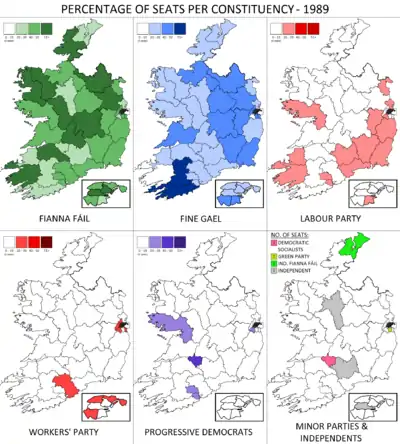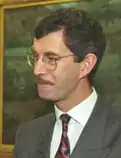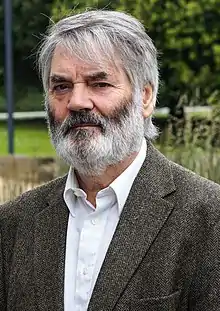1989 Irish general election
The 1989 Irish general election was held on Thursday, 15 June, three weeks after the dissolution of the Dáil on 25 May. The newly elected 166 members of the 26th Dáil assembled at Leinster House on 29 June. However, a new Taoiseach and a Fianna Fáil-Progressive Democrats government were not appointed until 12 July.
| |||||||||||||||||||||||||||||||||||||||||||||||||||||||||||||||||||||||||||||||||||||||||||||
165 of 166 seats in Dáil Éireann 84 seats needed for a majority | |||||||||||||||||||||||||||||||||||||||||||||||||||||||||||||||||||||||||||||||||||||||||||||
|---|---|---|---|---|---|---|---|---|---|---|---|---|---|---|---|---|---|---|---|---|---|---|---|---|---|---|---|---|---|---|---|---|---|---|---|---|---|---|---|---|---|---|---|---|---|---|---|---|---|---|---|---|---|---|---|---|---|---|---|---|---|---|---|---|---|---|---|---|---|---|---|---|---|---|---|---|---|---|---|---|---|---|---|---|---|---|---|---|---|---|---|---|---|
| Turnout | 68.5% | ||||||||||||||||||||||||||||||||||||||||||||||||||||||||||||||||||||||||||||||||||||||||||||
| |||||||||||||||||||||||||||||||||||||||||||||||||||||||||||||||||||||||||||||||||||||||||||||
 Percentage of seats gained by each of the three biggest parties, and number of seats gained by smaller parties and independents. | |||||||||||||||||||||||||||||||||||||||||||||||||||||||||||||||||||||||||||||||||||||||||||||
| |||||||||||||||||||||||||||||||||||||||||||||||||||||||||||||||||||||||||||||||||||||||||||||
The general election took place in 41 parliamentary constituencies throughout Ireland for 166 seats in the lower house of parliament, Dáil Éireann.
Campaign
The general election of 1989 was precipitated by the defeat of the minority Fianna Fáil government in a private members motion regarding the provision of funds for AIDS sufferers (haemophiliacs who had been infected with contaminated blood products by the HSE). While a general election was not necessary – the defeat was seen merely as an embarrassment for the government – the Dáil was dissolved nonetheless.
Charles Haughey, the Fianna Fáil leader, called the general election for another reason; opinion polls had shown that the party's strong performance in government had increased their popularity and an overall majority for Fianna Fáil could be a possibility. Also, rumours were current that the general election was called so that certain Fianna Fáil members could raise money privately for themselves. While these rumours were dismissed at the time, it was revealed more than ten years later that Ray Burke, Pádraig Flynn and Haughey himself had received substantial personal donations during the campaign.[1]
While it was thought that the general election would catch the opposition parties unprepared, they co-ordinated themselves and co-operated very quickly. Further cuts in spending, particularly in the health service, became the dominant issue. Alan Dukes was fighting his first (and as events would prove, his only) general election as leader of Fine Gael. His "Tallaght Strategy" had kept Fianna Fáil in power, governing as a minority, since 1987.
The general election was held on the same day as the elections to the European Parliament, and turnout was 68.5%.
Results
| 26th Irish general election – 15 June 1989[2][3][4] | ||||||||
|---|---|---|---|---|---|---|---|---|
 | ||||||||
| Party | Leader | Seats | ± | % of seats |
First Pref votes |
% FPv | ±% | |
| Fianna Fáil | Charles Haughey | 77 | 46.4 | 731,472 | 44.1 | |||
| Fine Gael | Alan Dukes | 55 | 33.1 | 485,307 | 29.3 | |||
| Labour | Dick Spring | 15 | 9.1 | 156,989 | 9.5 | |||
| Workers' Party | Proinsias De Rossa | 7 | 4.2 | 82,263 | 5.0 | |||
| Progressive Democrats | Desmond O'Malley | 6 | 3.6 | 91,013 | 5.5 | |||
| Green | None | 1 | 0.6 | 24,827 | 1.5 | |||
| Democratic Socialist | Jim Kemmy | 1 | 0.6 | 9,836 | 0.6 | |||
| Sinn Féin | Gerry Adams | 0 | 0 | 20,003 | 1.2 | |||
| Communist Party | James Stewart | 0 | 0 | 342 | 0.0 | — | ||
| Independent | N/A | 4 | 2.4 | 54,761 | 3.3 | |||
| Spoilt votes | 20,779 | — | — | |||||
| Total | 166 | 0 | 100 | 1,677,592 | 100 | — | ||
| Electorate/Turnout | 2,448,810 | 68.5% | — | |||||
- Fianna Fáil–Progressive Democrats coalition government formed.
Independents include Independent Fianna Fáil (6,961 votes, 1 seat), Army Wives (6,966 votes) and Gay candidates (517 votes).
- Notes:
- No by-elections had taken place during the previous Dáil. One seat in Sligo–Leitrim had been vacant at the dissolution of the previous (25th) Dáil caused by the resignation of the Fianna Fáil member Ray MacSharry.[5]
While Fianna Fáil had hoped to achieve an overall majority, the party actually lost seats. The result was a disaster for Fianna Fáil, particularly when the election was so unnecessary. Fine Gael made a small gain, but nothing substantial. The Progressive Democrats did badly, losing over half their deputies. The Labour Party and the Workers' Party gained working class votes from Fianna Fáil, but failed to make the big breakthrough, while Sinn Féin polled even worse than its 1987 result. The Green Party won its first seat when Roger Garland was elected for Dublin South.
Forming a government proved to be extremely difficult. Many in Fianna Fáil had hoped that the minority government could continue where it left off, particularly if the "Tallaght Strategy" continued. However, Fine Gael refused to support the government and so a deadlock developed. The prospect of forming a government seemed remote, so much so that Charles Haughey was forced to formally resign as Taoiseach. For the first time in Irish history a Taoiseach and a government had not been appointed when the new Dáil met. However, twenty-seven days after the general election, Fianna Fáil entered into a coalition government for the first time in its history – with the Progressive Democrats.
Voting summary
Seats summary
Dáil membership changes
The following changes took place as a result of the election:
- 14 outgoing TDs retired
- 1 vacant seat at election time
- 150 outgoing TDs stood for re-election (also Seán Treacy, the outgoing Ceann Comhairle who was automatically returned)
- 124 of those were re-elected
- 26 failed to be re-elected
- 41 successor TDs were elected
- 32 were elected for the first time
- 9 had previously been TDs
- There were 4 successor female TDs, replacing 5 outgoing, thus reducing the total by 1 to 13
- There were changes in 30 of the 41 constituencies contested
Where more than one change took place in a constituency the concept of successor is an approximation for presentation only.
See also
References
- Page 87 of Foot in Mouth: Famous Irish Political Gaffes by Shane Coleman. ISBN 1842103768
- "26th Dáil 1989 General Election". ElectionsIreland.org. Retrieved 12 July 2009.
- "Dáil elections since 1918". ARK Northern Ireland. Retrieved 12 July 2009.
- Dieter Nohlen & Philip Stöver (2010) Elections in Europe: A data handbook, pp1009-1017 ISBN 978-3-8329-5609-7
- "Dáil Éireann By Election Writs 1918–2005". ElectionsIreland.org.
- Ray MacSharry became European Commissioner in 1988, but no by-election was held.
Further reading
- O'Leary, Brendan, and John Peterson. "Further Europeanisation? The Irish General Election of June 1989." West European Politics 13#1 (1990): 124-136.
- Sinnott, Richard. Irish voters decide: Voting behaviour in elections and referendums since 1918 (Manchester University Press, 1995).
External links
- GuthanPhobail.net, Results (in Irish)
_Rueda_de_prensa_de_Felipe_Gonz%C3%A1lez_y_el_primer_ministro_de_Irlanda._Pool_Moncloa._25_de_abril_de_1990_(cropped).jpeg.webp)


.jpg.webp)